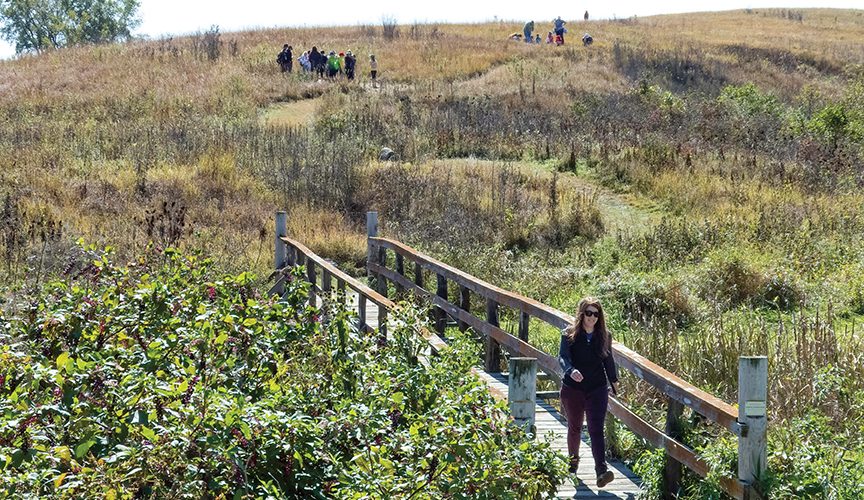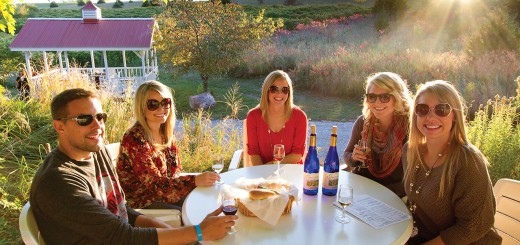Spring Creek Prairie Audubon Center

by Tegan Colton
A crescendo of calls, chirps, hoots, bellowing croaks and soprano twitters greet visitors to the historic Spring Creek Prairie Audubon Center at all hours of the day.
The wildlife preserve 20 minutes south of Lincoln at 11700 S.W. 100th St., Denton, is dedicated to conserving Nebraska’s birds and animals and the habitats they need to thrive. Nestled between a canopy of trees and a rustling field of tallgrass, Spring Creek gives visitors a chance to enjoy all the bounty Nebraska’s prairie has to offer all year long.
The National Audubon Society bought the land from local rancher Kathie O’Brien in 1998 to preserve one of the last vestiges of Nebraska tallgrass prairie left untouched by plowing and agricultural change. O’Brien’s family, which settled the land in 1901, left the 850 acres to blossom—with a pristine ecosystem perfect for Nebraskan birds, insects, wildcats, muskrats, frogs, shrubs and flowers of all kinds. Spring Creek is dedicated to preserving the land from future plowing to protect what is now among the rarest ecosystems in the world.
Listed in the National Register for Historic Places, Spring Creek also contains wagon ruts associated with 19th century travel on the Oregon-California Trail. These extraordinary relics of the Oregon Trail, used by pioneers and Mormons from 1860 to 1866, remain clearly etched into Spring Creek’s landscape some 160 years later. The careful preservation of the ruts, along with acres of beautiful tallgrass prairie, makes visiting Spring Creek feel like a step into the past.
Spring Creek’s director, Meghan Sittler, and her team of dedicated staff and volunteers attend to the land year-round, using monthly prescribed burns—man-made, controlled wildfires—to simulate lightning strikes that would otherwise start fires naturally and be more difficult to control. Grassland species evolved to withstand and even rely on wildfires to thrive, so the monthly also help control the spread of invasive species. The team uses herds of cattle to graze the tallgrass and keep it groomed, a role that was originally filled by thousands of wild bison.
Spring Creek Prairie Audubon Center is open to visitors of all ages for a small admission fee. Visitors are encouraged to enjoy the three miles of trails that run through and alongside creeks, shrubs, trees and wildflowers. Inside the building, visitors can read about the tallgrass prairie ecosystem and study samples of local honeycomb, snakeskin, feathers, grass, flowers and insects under microscopes. Visitors also can learn about the prairie birds that call Spring Creek home and track sightings in the on-site database. Along with plenty of educational opportunities, the building houses a whimsical gift shop where visitors can buy greeting cards, plush replicas of native birds, wildlife identification guides of all kinds, books and poems by local writers, art, T-shirts, merchandise and souvenirs.
Hands-on experiential opportunities make the center an ideal place for field trips, and thousands of grade school students visit every year. Students are encouraged to explore the indoor and outdoor areas using all of their senses to spark curiosity. Using what’s called inquiry-based learning, Spring Creek staff ask students to generate questions about the environment and to try to find the answers by observation and exploration. Spring Creek staff hope that by inviting students to explore and ask questions in this way, they’ll fall in love with the prairie and someday work to preserve it.
The staff regularly hosts educational opportunities for farmers, ranchers and all other interested parties. When farmers plow the ground to make way for their crops, it becomes less hospitable for native plants. This disruption in the ecosystem has devastating effects on the birds and other animals that rely on the balance of the ecosystem to thrive, causing many species to either migrate or die out. Spring Creek hopes to educate local farmers and agricultural engineers about how they can farm land while preserving tallgrass prairie around it. Staff and volunteers teach farmers how to properly execute prescribed burnings to maintain the health of the land while keeping it safe. They also teach ways to include cattle in grazing the land and how to ensure Nebraska’s natural waterways and wells of clean, fresh water continue to thrive and feed creeks and rivers.
And for the average bird enthusiast, the environmentalist or the simply curious, Spring Creek hosts fun, educational events year-round. In late June, family picnics feature educational topics, games and outdoorsy activities. In July, a weekly series of yoga and guided meditations appeal to people at every level. Spring Creek also regularly hosts Third Tuesday Bird Walks, where birders meet bright and early to sharpen their skills as they spot everything from western meadowlarks to sandhill cranes. On select days, visitors can go on guided wildflower tours, learning to identify native species like the bright red and yellow golden tickseed or the round clusters of deep magenta prairie phlox.
Along with being serenaded by the chorus of native songbirds, visitors can spend hours sightseeing, birdwatching, hiking and simply enjoying the spirit of Nebraska’s prairie. Join Spring Creek in helping preserve and restore what’s left of Nebraska’s prairie by visiting, donating or volunteering.
For more information, see springcreek.audubon.org.




Recent Comments